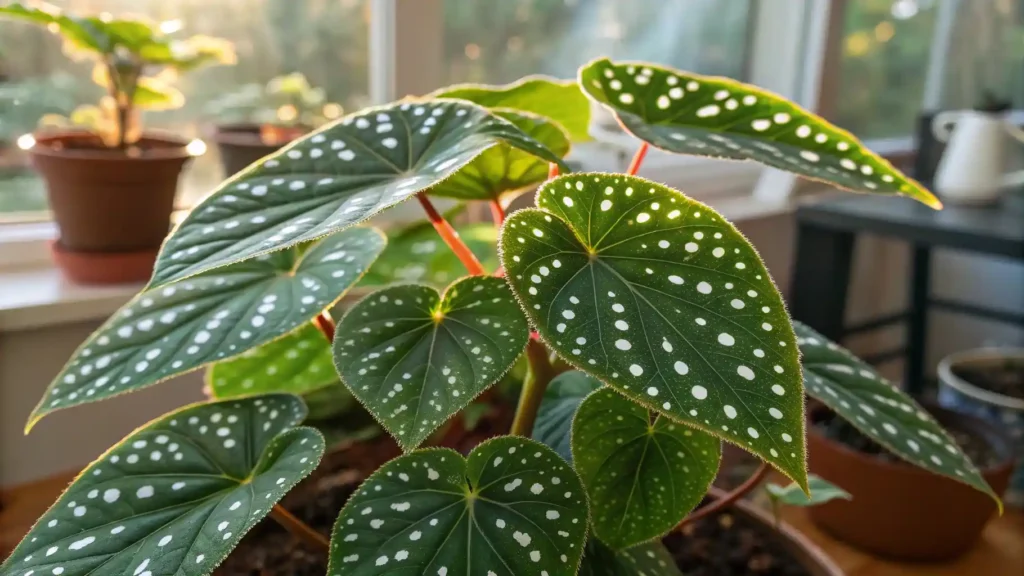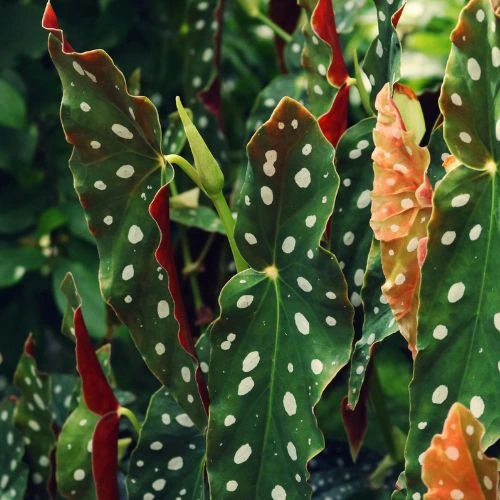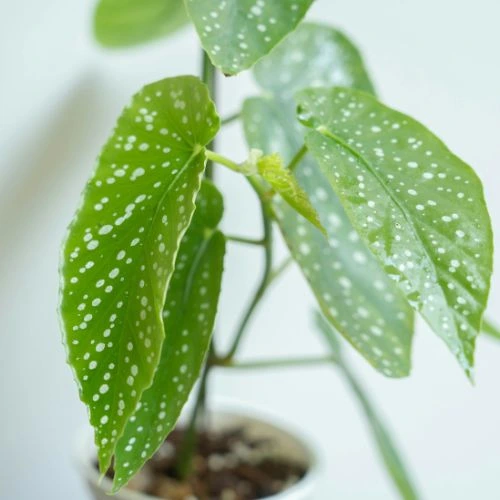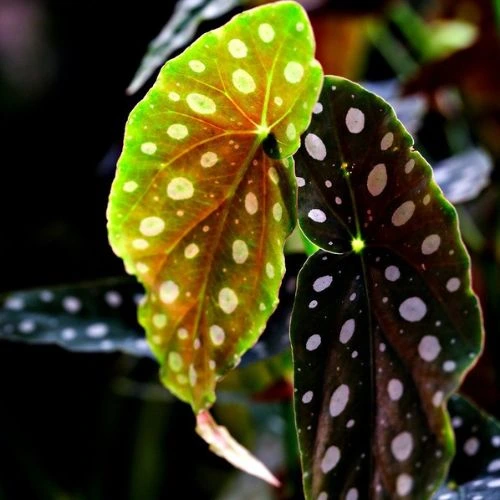Table of Contents
Imagine a stunning plant that feels like a living work of art—the Begonia Maculata, with its dazzling polka-dotted leaves and vibrant red undersides, is exactly that. This houseplant doesn’t just add beauty to your space; it sparks joy and becomes a conversation starter. But like all masterpieces, it requires care to shine its brightest. Whether you’re a seasoned green thumb or a curious beginner, this comprehensive guide on Begonia Maculata care will help you nurture this botanical gem with confidence. Let’s uncover the secrets to keeping your Polka Dot Begonia healthy, happy, and thriving!
| Common Name | Polka Dot Begonia |
| Botanical Name | Begonia Maculata |
| Family | Begoniaceae |
| Plant Type | Perennial, Indoor Plant |
| Mature Size | 1–2 feet tall |
| Bloom Time | Spring and Summer |
| Toxicity | Toxic to pets and humans if ingested |
| Sun Exposure | Bright, Indirect Light |
| Soil Type | Well-draining mix (potting soil + perlite/peat) |
| Soil pH | Slightly acidic (6.0–6.5) |
| Flower Color | White or Pale Pink |
| Hardiness Zones | USDA 10–11 |
| Native Area | Brazil |

What Makes Begonia Maculata Unique?
When it comes to standout houseplants, the Begonia Maculata truly steals the show. Known for its iconic polka-dotted leaves and striking red undersides, this plant brings an unmatched charm to any indoor space. Whether you’re a seasoned gardener or just starting your green journey, understanding what makes this plant special is key to mastering Begonia Maculata care.
One of its most captivating features is its foliage. The glossy green leaves, adorned with silvery-white spots, give it the nickname “Polka Dot Begonia.” Flip the leaves over, and you’ll see a vibrant reddish hue that adds even more visual appeal. This unique combination of colors makes it a favorite among plant enthusiasts who love a touch of elegance in their indoor gardens.
Beyond its looks, the Begonia Maculata is valued for being relatively low-maintenance when provided with the right care. It thrives in bright, indirect light and adapts well to indoor environments, making it ideal for homes or apartments. Plus, with proper Begonia Maculata care, you’ll enjoy its occasional clusters of small, white flowers that bloom during the growing season.
This plant isn’t just beautiful; it’s versatile too. Whether you display it in a hanging basket, on a windowsill, or as a centerpiece, it effortlessly enhances the aesthetic of any space. Its unique appearance and adaptability make it a must-have for anyone looking to add a statement piece to their indoor plant collection.



Essential Begonia Maculata Care Tips
Caring for a Begonia Maculata, or Polka Dot Begonia, may seem challenging at first, but with the right approach, this stunning plant can thrive in your home. Here’s a step-by-step guide to mastering Begonia Maculata care, ensuring it stays healthy and vibrant all year round.
1. Light Requirements
To maintain the Begonia Maculata’s iconic polka-dotted leaves, providing the right light is crucial. This plant loves bright, indirect sunlight. The ideal placement is close to a window facing east or north. Too much direct sunlight can scorch its leaves, leaving unsightly marks, while too little light will cause the plant to lose its vibrant colors. Consider sheer curtains or placing it slightly away from the window for the perfect balance.
2. Proper Watering Techniques
Watering your Begonia Maculata correctly is essential to avoid common issues like root rot. The top inch of soil should dry before watering again. Use lukewarm water, and make sure the pot has drainage holes to prevent water from pooling at the bottom. Be cautious of overwatering which may kill your plant.
3. Ideal Soil for Begonia Maculata
The right soil ensures your plant’s roots stay healthy and oxygenated. Choose a well-draining potting mix, such as one that combines standard potting soil with perlite or peat moss. Slightly acidic soil with a pH of 6.0–6.5 works best. Good drainage prevents water from sitting in the soil, which can lead to fungal issues.
4. Maintaining Humidity Levels
Begonia Maculata thrives in a humid environment, with 50–60% humidity being ideal. If your home is dry, especially in winter, there are simple ways to boost humidity:
- Position your plant on a pebble tray filled with water.
- Group it with other humidity-loving plants.
- Invest in a small humidifier if you suffer from dry air.
- Put saucers filled with water near your plant.
- Place your plant in a high level’s humidity area such as the bathroom or kitchen.
- Keep your Begonia away from heaters or air conditioners, as these can dry out the air.
5. Fertilizing Your Polka Dot Begonia
Feed your Begonia Maculata every 2–4 weeks during the spring and summer growing seasons. Use a balanced liquid fertilizer diluted to half strength to avoid overfeeding, which can damage the roots. Fertilizing in the fall and winter is not advisable as the plant’s growth slows down.
By following these essential tips, you can ensure your Begonia Maculata remains a beautiful and healthy addition to your indoor garden. Proper Begonia Maculata care not only preserves its stunning polka-dotted leaves but also encourages it to grow and even bloom, adding a touch of elegance to your space.
Pruning and Maintenance
Pruning is a key part of Begonia Maculata care, helping to keep your plant healthy and encourage new growth. Regular maintenance not only maintains its stunning appearance but also prevents potential problems.
First,remove any dead, yellowing, or damaged leaves. These can drain energy from the plant and make it more susceptible to pests or diseases. Use clean, sharp scissors or pruning shears to make clean cuts, reducing the risk of infections.
To promote a bushier appearance, trim leggy stems just above a node (the spot where leaves or stems grow). This encourages branching and fuller growth. For best results, prune during the active growing season, typically spring or summer.
Don’t forget to clean your plant! Dust can accumulate on the polka-dotted leaves, dulling their shine. Gently wipe them with a damp cloth to keep them vibrant and free of pests.
With these simple tips, Begonia Maculata care becomes effortless!
Repotting Tips
Repotting is an important step in Begonia Maculata care to ensure healthy root growth and prevent overcrowding. Typically, this plant needs repotting every 2–3 years or when its roots outgrow the pot. Signs it’s time to repot include roots peeking out from drainage holes or soil that dries out too quickly.
Select a slightly larger pot with proper drainage holes to avoid waterlogging. Use fresh, well-draining soil, such as a mix with perlite or peat moss. Repot during spring, the active growing season, to minimize stress. With proper care, your Begonia will thrive in its new home!
Common Problems and How to Fix Them
Even with proper Begonia Maculata care, you might encounter a few common issues. Identifying these problems early can help you address them and keep your plant thriving.
1. Yellowing Leaves
Overwatering and insufficient light are usually the principal causes of Yellow leaves. Check the soil’s moisture—if it’s soggy, let it dry out before the next watering. Light conditions should be adjusted by moving your plant to a spot with bright, indirect sunlight.
2. Brown Leaf Edges
Dry, brown edges on the leaves are typically a sign of low humidity or underwatering. Boost humidity levels by using a pebble tray, grouping plants, or running a humidifier. Ensure you’re watering consistently when the top inch of soil feels dry.
3. Pests
Spider mites, aphids, and mealybugs are the most common pests affecting Begonia Maculata. They can cause leaf discoloration and damage. Combat pests by wiping the leaves with a damp cloth and spraying the plant with insecticidal soap or neem oil. Inspect your plant regularly to catch infestations early.
By staying proactive and addressing these issues quickly, you’ll ensure your Begonia Maculata care routine keeps your plant healthy, beautiful, and free of stress!
FAQs
How often should I water my Begonia Maculata?
Watering once a week when the top inch of your Begonia’s soil feels dry. But the frequency of watering may vary depending on your home’s humidity and temperature. Avoid overwatering to prevent root rot.
Can Begonia Maculata grow outdoors?
Yes, in USDA zones 10–11, it can thrive outdoors in a shaded spot. In cooler climates, it’s best grown indoors or moved inside during colder months.
Why are my Begonia Maculata leaves drooping?
Drooping leaves usually indicate underwatering, overwatering, or insufficient light. Depending on the soil’s moisture level, adjust your watering schedule as needed. Ensure it gets bright, indirect light.
How do I make my Begonia bushier?
Prune leggy stems just above a node to encourage branching and fuller growth. Regular pruning is a simple yet effective step in Begonia Maculata care.
Bonus Tips for Thriving Begonia Maculata Plants
- Rotate your plant weekly to ensure even light exposure and balanced growth.
- Clean the polka-dotted leaves gently with a damp cloth to remove dust and maintain their vibrant shine.
- Avoid placing your Begonia near drafts, heating vents, or air conditioners, as sudden temperature changes can stress the plant.
- Use a stake or support for taller plants to keep stems upright and prevent breakage.
- Keep an eye on new growth; it’s a sign your plant is happy and healthy!
Conclusion
Caring for a Begonia Maculata doesn’t have to be overwhelming. With the right light, water, and a bit of attention, this plant will reward you with its unmatched beauty and charm. Whether you’re troubleshooting common issues or giving your plant the care it deserves, you’re well on your way to success. Ready for more tips on creating a flourishing indoor garden? Subscribe to our newsletter today for expert advice and inspiration straight to your inbox!

